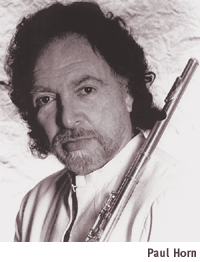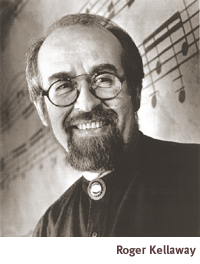
Jazz Greats Paul Horn And Roger Kellaway Finally Get Together On Stage.
By Dave Irwin
IT WILL BE an historic event when flautist Paul Horn and
pianist Roger Kellaway play in Tucson on Friday, February 19.
Despite a friendship going back decades and many private jam sessions,
the two jazz warhorses have never performed in public together.
 "We'll probably wish that we had two nights,"
laughs Kellaway. "We're going to play standards
and do solos and some improvisation. We look at life the same
way. We have a lot in common. It'll be a very rich experience."
"We'll probably wish that we had two nights,"
laughs Kellaway. "We're going to play standards
and do solos and some improvisation. We look at life the same
way. We have a lot in common. It'll be a very rich experience."
Paul Horn is an underappreciated giant in the jazz world. He
lives part of the year in Tucson. In 1968, his landmark album
Inside the Taj Mahal heralded a more mellow, laid-back
form of improvisation, a turning away from the dissonance and
frantic chaos of the Coltrane era. Combined with its location
recording, which added the echoey acoustics of India's
most famous building in addition to its spiritual and cultural
vibe, Inside the Taj Mahal is considered the seminal precursor
to the entire New Age/contemporary instrumental genre.
"There's a lot of melody there because that's
my training and I think melodically," Horn says of the album.
"It's who I am, my background, coming through my
music at that time."
With more than 40 albums to his credit, Horn, now a vibrant oldster
who looks and acts much younger than a man nearing 70, says, "New
Age didn't exist when I did that album. As far as I'm
concerned, I'm just playing music that I feel to play.
If you want to call it New Age, I don't care. I don't
have to prove anything anymore."
In 1966, Horn had traveled to India, ahead of the Beatles, to
learn transcendental meditation from Maharishi Mahesh Yogi. Although
his form of practice has changed, he still meditates every day.
He has always considered his life a spiritual journey which he
expresses through sound.
Kellaway also is largely underappreciated. Now nearing 60 himself,
he's appeared on more than 200 albums and written 23 film
scores. Ironically, he's most famous for "Remembering
You," the closing piano instrumental on the TV show All
In The Family. He's played with everyone from Yo-Yo
Ma to Don Ellis, Sonny Rollins, Duke Ellington, Joni Mitchell
and Bobby Darin.
 The year was 1967, the cultural earthquake of the Summer of Love,
and an era of experimentation and inner exploration. A famous
and very hip musician shared a new high he'd found--meditation
techniques he'd learned--with a younger musician.
That cemented the relationship between Horn and Kellaway, who
also has continued to meditate daily throughout the years.
The year was 1967, the cultural earthquake of the Summer of Love,
and an era of experimentation and inner exploration. A famous
and very hip musician shared a new high he'd found--meditation
techniques he'd learned--with a younger musician.
That cemented the relationship between Horn and Kellaway, who
also has continued to meditate daily throughout the years.
Because of the demands on their time and different tour schedules,
the two have not seen each other since 1981. They've stayed
in touch via phone and listening to each other's albums.
They'll spend several days together before the concert--talking,
playing and being old friends.
"That's something I've wanted to do for
a long time," Kellaway said. "Just hang out with
him and discuss existence and meditation. We've never really
gotten a chance to catch up."
Horn is surprised to learn it's been so long since he's
seen his friend. "We talk on the phone, so I forget we're
not seeing each other in person."
Both musicians were classically trained before expanding their
skills into jazz. Horn, with a master's degree from the
Manhattan School of Music, played with Chico Hamilton in the late
'50s before launching his solo career. He moved to Hollywood,
hanging out with Miles Davis and Tony Bennett, much in demand
for studio work and winning Playboy and Downbeat
polls. Over the years, he's fused jazz and world music
by featuring famous locations, including the Great Pyramid in
Egypt. A recent album now awaiting release, recorded in a Tibetan
monastery, closes what he feels is a trilogy with his earlier
Taj Mahal and Pyramid works.
Kellaway moves between the jazz and classical worlds as a composer,
performer and conductor. His hero is Igor Stravinsky and in 1970
he got to work with Stravinsky's long-time collaborator,
George Balanchine, to create a ballet. He's also worked
with minimalist composer Steve Reich, recording "Four Organs."
 "People keep trying to figure out why I play the way I
play from the history of jazz piano," he explains. "You
can not do that. There are many aspects of the history of jazz
piano that affect how I play, but there's also 35 or 40
years of classical piano that influence how I play spatially,
and how I make my clusters. One idea superimposes another. So
you expand yourself out of the category of jazz pianist into being
an improviser who uses jazz, which is the thing that unites Paul
and me. We're both classically trained and we're
both jazz people. But we've expanded the idea of improvisation
to take in other areas. That's one of the reasons we're
excited about playing together. Because we're older and
(because of) the training we have, there's more depth (to)
that improvisation."
"People keep trying to figure out why I play the way I
play from the history of jazz piano," he explains. "You
can not do that. There are many aspects of the history of jazz
piano that affect how I play, but there's also 35 or 40
years of classical piano that influence how I play spatially,
and how I make my clusters. One idea superimposes another. So
you expand yourself out of the category of jazz pianist into being
an improviser who uses jazz, which is the thing that unites Paul
and me. We're both classically trained and we're
both jazz people. But we've expanded the idea of improvisation
to take in other areas. That's one of the reasons we're
excited about playing together. Because we're older and
(because of) the training we have, there's more depth (to)
that improvisation."
Kellaway also notes the influence of meditation on his work.
"If my music has become more melodic, it's really
only deepened its sense of melodic content. Because I continue
to meditate, my evolving being affects my music and its depth."
"He's a well-kept secret," Horn adds. "We
both bring solo skills and the ability to fit into any situation.
We both have our own inner time. We have a love and respect for
each other on a lot of levels. The only thing that's held
me together all these years is jazz, because I never know what's
going to happen. There's a different energy and it's
never boring. It'll be a long concert--It's
going to be some nice music."
The Tucson Jazz Society presents Paul Horn and Roger Kellaway
in concert at 7:30 p.m. Friday, February 19, at St. Philip's
in the Hills Episcopal Church, 4440 N. Campbell Ave. Tickets
are $15, $12 for TJS members. For tickets and information, call
the TJS hotline at 743-3399.

|





